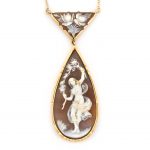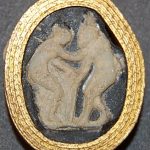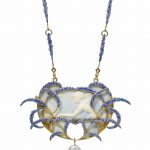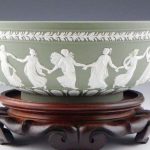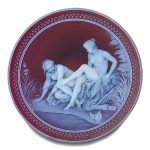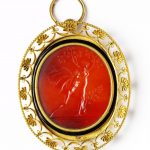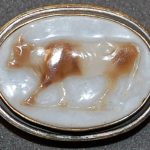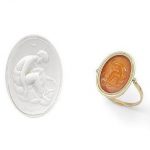Nymphs were graceful beings who presided over the woods, grottoes, streams and streams etc. They were depicted as beautiful maidens of fairy-like form and robed in more or less shadowy garments.
There were three main classes of nymphs. These were water, mountain and tree or wood nymphs. Reference: Myths and Legends of Greece and Rome by E M Berens 1892 edition.
A shell cameo pendant/necklace a dancing nymph cameo suspended from a floral motif cameo; mounted in fourteen karat gold; length: 18 1/4in.
Sold for US$ 1,000 (£ 760) inc. premium at Bonhams in 2013
Cameo of glass paste imitating sardonyx, engraved with a satyr about to embrace a nymph, who repels his advances. Culture/period: Roman Imperial (early) term details Date 1st Century – 2nd Century
Reference: © The Trustees of the British Museum
AN ART NOUVEAU GALALITH, ENAMEL AND PEARL PENDENT NECKLACE, BY RENÉ LALIQUE The galalith cameo pendant figuring the profile of a nymph, set within a spray of lavender flowers, suspending a baroque pearl, to the similarly-set chain, circa 1905, pendant 9.5 cm, chain 66.0 cm, with French assay marks for gold Signed Lalique Please note that the pearl has not been tested for natural origin.
Sold for CHF 348,500 at Christies in 2017
WEDGWOOD JASPERWARE GREEN DANCING HOURS DRAPED BOWL Large Vintage Wedgwood Jasperware Solid Olive Green High Relief Cameo Bowl Dancing Draped Women Nymphs Ladies & Urn Impressed Wedgwood, Made in England, Laurel leaf band trim at top, with draped female figures in the surround in cameo relief and would make an impressive addition to any fine household or collection.
Sold for $475 at Kotler Galleries & Auctioneers in 2018
DIANA AND NYMPH BATHING A FINE THOMAS WEBB CAMEO PLAQUE by George Woodall, Amblecote, circa 1878 signed, the circular form in opaque-white over translucent dark purplish brown glass, acid-dipped and cameo-carved with two classical nude figures at the water’s edge, a bow and quiver of arrows to one side, within a rosette and husk border, some very slight highlighting to the figures in gilding engraved and gilt ‘G. Woodall’, paper collector’s label inscribed CG-10 and another label inscribed F1499 25.7cm., 10in.
Sold for 36,000 GBP at Sothebys in 2007
Vertical oval intaglio. Red translucent carnelian. On the right a male figure, probably Apollo, naked except for a cloak, reaches left to clasp the figure of a naked female, probably Daphne, who is being transformed into a tree. She faces left, her feet and arms sprouting branches. Set in a gold filigree mount with a line of black enamel.
This gem is in the neo-classical style popular in the late 1700s and early 1800s, when taste in the arts echoed the subject matter and style of the Greek and Roman masters. Thousands of gems were made in this style in Italy and brought back by British Grand Tourists, who went there to visit the newly-discovered classical antiquities and archaeological sites. It once belonged to the collection of Prince Stanislas Poniatowski (1754-1833), a wealthy collector who commissioned about 2500 engraved gems and encouraged the belief that they were ancient. Many even bore the signatures of the most celebrated Greek and Roman engravers. The collection was sold in 1839 following Poniatowski’s death, and later the scandal of its true background emerged and many gems subsequently changed hands for very low prices and were widely dispersed. The Poniatowski affair is often credited with causing a loss of confidence in the market for engraved gems, and the subsequent decline in the art from the mid nineteenth century onwards. Nowadays, ironically, the Poniatowski collection is of increasing interest as most of the gems were the work of a small group of neo-classical gem-engravers in Rome, including most probably the great Luigi Pichler (1773-1854),and have come to be regarded as important works of gem-engraving. The engravers of the Poniatowski gems took their subjects from classical literature, especially the works of Homer, Virgil and Ovid. Two identifications can be made of the scene depicted in this gem, both involving nymphs in flight from seduction. The first is second is that it shows the god Apollo in his pursuit of the nymph Daphne, who rejected his advances. As Apollo gained on her she appealed to her father Peneus, who took pity on her and changed her into a laurel tree. The second is that it shows the mythical hero Peleus in his attempt to rape the nymph Thetis, with whom he eventually married and fathered Achilles. Thetis is in the act of transforming herself into a tree to escape his advances.
Reference: © Victoria and Albert Museum
